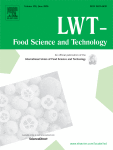Ver ítem
- xmlui.general.dspace_homeCentros Regionales y EEAsCentro Regional Santa FeEEA RafaelaArtículos científicosxmlui.ArtifactBrowser.ItemViewer.trail
- Inicio
- Centros Regionales y EEAs
- Centro Regional Santa Fe
- EEA Rafaela
- Artículos científicos
- Ver ítem
Milk fortified with calcium: Changes in the physicochemical and rheological characteristics that affect the stability
Resumen
The objective of this work was to analyze the changes in the physicochemical and rheological characteristics of milk fortified with different calcium salts. Reconstituted milk samples using skim milk powder with different concentrations of calcium chloride and calcium lactate (0, 5 and 30 mmol kg−1) were obtained. Several physicochemical and rheometric techniques were used to analyze the effect of milk fortification. According to the results, all the
[ver mas...]
The objective of this work was to analyze the changes in the physicochemical and rheological characteristics of milk fortified with different calcium salts. Reconstituted milk samples using skim milk powder with different concentrations of calcium chloride and calcium lactate (0, 5 and 30 mmol kg−1) were obtained. Several physicochemical and rheometric techniques were used to analyze the effect of milk fortification. According to the results, all the applied techniques indicated that some of the added calcium migrates into the casein micelle forming colloidal calcium phosphate, and that the calcium added as lactate enters the micelles to a greater extent. A part of whey proteins would also be integrated into the micellar structure. An addition of 5 mmol kg−1 of calcium chloride and calcium lactate would be practically feasible, due to the mineral balance and the thermal stability that were not significantly affected at that concentration level. In conclusion, the results obtained with physicochemical techniques commonly used in literature are in agreement with those obtained in this study by rheometry, demonstrating that this simple and rapid technique allows inferring about the changes in mineral balance and effects on thermal stability when different salts are used for milk fortification.
[Cerrar]

Autor
Acosta, Nadia Belen;
Sihufe, Guillermo Adrián;
Meza, Bárbara Erica;
Marino, Fernanda;
Costabel, Luciana Maria;
Zorrilla, Susana E.;
Olivares, María Laura;
Fuente
LWT - Food Science and Technology 134 : 110204 (December 2020)
Fecha
2020-09
Editorial
Elsevier
ISSN
0023-6438
Formato
pdf
Tipo de documento
artículo
Palabras Claves
Derechos de acceso
Embargado
 Excepto donde se diga explicitamente, este item se publica bajo la siguiente descripción: Creative Commons Attribution-NonCommercial-ShareAlike 2.5 Unported (CC BY-NC-SA 2.5)
Excepto donde se diga explicitamente, este item se publica bajo la siguiente descripción: Creative Commons Attribution-NonCommercial-ShareAlike 2.5 Unported (CC BY-NC-SA 2.5)

